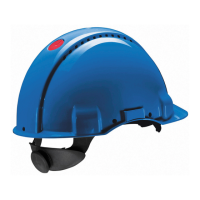9
GZXO
3M™ Peltor™ G3000 Helmet
With 3M™ Peltor™ Patented Uvicator™ Sensor
INTENDED USE
This product meets the requirements of EN 397:1995,
Industrial Safety Helmets. This product also meets the
optional requirements for very low temperatures
(-30°C). Versions are available that also ful¿l the
requirements for electrical insulation and molten metal
splash. This product is designed to protect the wearer
against objects likely to strike the head. See all
instructions for use and save for continuing reference.
^
Particular attention should be given to warning
statements where indicated.
^
WARNINGS
Always be sure that the complete product is:
- Suitable for the application;
- Fitted correctly;
- Worn during all periods of exposure;
- Replaced when necessary.
Proper selection, training, use and appropriate
maintenance are essential in order for the product to
help protect the wearer from impact hazards.
Failure to follow all instructions on the use of these
personal protection products and/or failure to properly
wear the complete product during all periods of
exposure may adversely affect the wearer's health, lead
to severe or life threatening illness or permanent
disability.
For suitability and proper use follow local regulations,
refer to all information supplied or contact a safety
professional/3M representative (Local Contact Details).
Never alter or modify this product, unless recommended
by the manufacturer.
Never use this helmet if it is cracked or cut. A helmet
that has been involved in an impact but shows no sign
of damage should always be replaced.
Do not apply paint, solvents, adhesives or self-adhesive
labels to the helmet. If it is important to stick anything to
the helmet, only use rubber or acrylic based adhesives.
Direct contact with sprays, Àuids or other substances
containing solvents and/or alcohols can reduce the
durability of the helmet and should therefore be avoided.
Use of the helmet should be kept within industrial areas
only and the helmet should not be used in any other
application such as horse riding or bike riding.
Always ensure that the head harness is well maintained
and correctly adjusted to the users head.
If in doubt contact your safety of¿cer or 3M for further
advice.
PREPARATION FOR USE
Inspection
Ensure that the head harness is always attached to the
helmet at the appropriate points and securely ¿tted to
the head before it is worn.
Before each use the helmet should be inspected for
cracks, cuts or other damage and should be rejected
and disposed of if these are discovered.
Fitting
For adequate protection the helmet must ¿t or be
adjusted to the size of the users head.
Insert the 3 harness holders into the helmet grooves
(See ¿gure 1).
^
It is important that the headbands are properly
tensioned in their attachments.
This product is also approved with the interior rotated
180°.
Helmet adjustment
Adjust the nape strap to ¿t the wearers head correctly.
Once the nape strap has been tightened so that the
helmet sits securely, press the studs into the holes.
The height of the head harness can be set at a choice of
3 vertical height settings for optimum comfort (See
¿gure 2).
IN USE
The key factors for a helmet's 'in use' life are exposure
to external force, chemicals and ultraviolet (UV)
radiation. Physical and chemical damage are usually
easy to detect, whilst UV radiation damage is harder.
The rate at which radiation gradually breaks down
plastic depends on where and how much the helmet is
used.
The 3M™ Peltor™ Uvicator™ lets you know when to
change your helmet. It is calibrated to detect the amount
of UV radiation received and gradually changes colour
over time.
The 3M™ Peltor™ Uvicator™ changes, clockwise, from
red to white. When the 3M™ Peltor™ Uvicator™ has
turned completely white the helmet has received the
maximum tolerable amount of radiation and must be
replaced.

